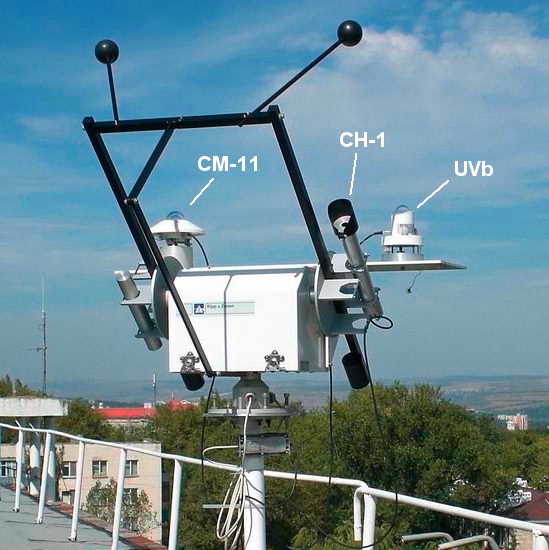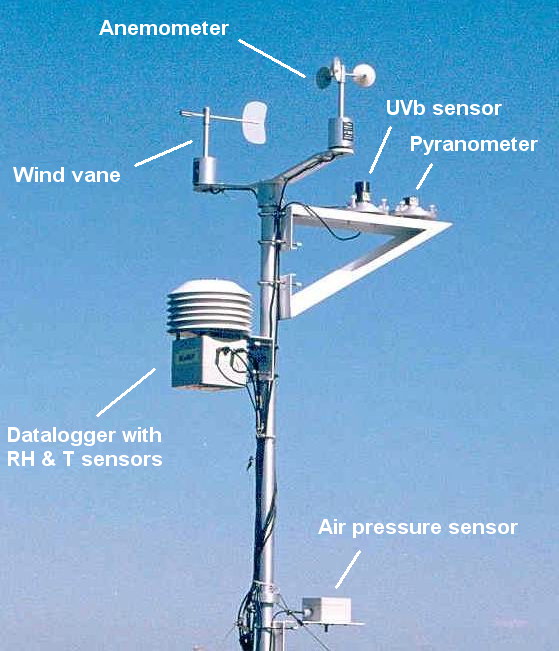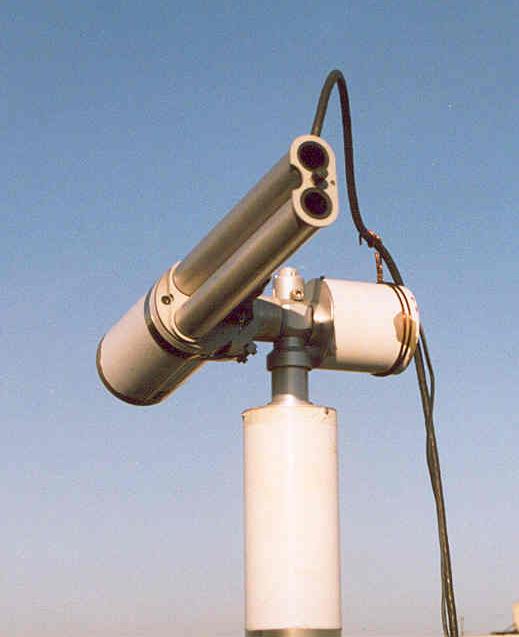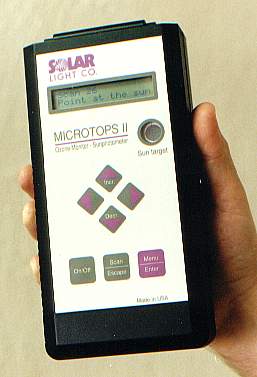
 A T M O S P H E R I C
A T M O S P H E R I CR E S E A R C H
G R O U P

 A T M O S P H E R I C
A T M O S P H E R I C| Rus |

Automatic solar tracker unit 2AP BD (Kipp&Zonen BV, the Netherlands)To carry out measurements for direct and diffuse components of incoming solar radiation we need to use an active solar tracking system equipped with pyrheliometer(s) and pyranometer(s), and Shading Arm Kit. The 2AP BD tracker is an all-weather, reliable and affordable tracking and positioning instrument. It is widely used in typical applications which include solar tracking as a part of Scientific Solar Monitoring Station. Fully automated system with two stepper motors (in azimuth and zenith directions) is used simultaneously for precise pointing pyrheliometers at the sun ( direct irradiance measurement) and for shading pyranometers (diffuse irradiance measurement); accuracy of tracking < 0.15°, resolution reaches the value of 0.0036°. 2AP BD unit runs unattended for a long period of time after initial setup and it requires only occasional checks of the internal clock. |
The pyranometer CM 11 for measurements radiation in W/m2
Specifications:
| Pyrheliometer CH 1 for measurements direct
solar radiation in W/m2
Specifications:
| UV-S-B-C Radiometer for measurements of solar ultraviolet UVb radiation in W/m2
Specifications:
|

The CG 1 Pyrgeometer for IR (infrared) radiation measurement
Specifications:
| SP Lite for routine measurement of solar radiation
Specifications:
| PAR Lite is designed for outdoor measurement of photosynthetically active radiation (PAR) in natural daylight
Specifications:
| UV-S-A-C Radiometer for measurements of solar ultraviolet UVa radiation in W/m2
Specifications:
|
Data Logger CR-10X 4M (Campbell Scientific Co. ,UK)
Data Logger CR-10X 4M is a rugged instrument with a research-grade performance. CR-10X 4M is a rugged measurement and control system that delivers accurate, reliable measurements in a variety of applications. Such characteristics as the measurement precision, flexibility, long-term reliability, and economic price of the Data Logger CR-10X 4M, make this instrument highly suitable for our research activity, and measurement and store applications.
The instrument has precise 13 bits A/D converter of signals, assures of 0.1% accuracy; fulfills data acquisition, temporary stores in battery backed 128K memory extended up to 4 Mb (with using non-volatile Flash memory card) and transfers data to PC through direct links using SC32A RS-232 Interface. Data logger has 12 single ended mV inputs with common ground or 6 fully floating differential inputs, which are individually configured.
Channel expansion is provided by low level voltage AM25T multiplexer on 25 differential voltages in one differential input channel. Extensive calculation functions are available. Scan rates are programmable from 1/64 sec to 2.5 hours. Output intervals for row or processed data are user-specified. Full scale of analog inputs ranges from +/- 2.5mV to +/- 2.5V.
Memory extension up to 2Mb will allow to carry out measurements in unattended regime for 2-4 months depending on number of channels used by sensors and other devices.
Our configuration: memory extension up to 4 Mb(external), number of channals - 9, type of channals - differential, sample rate - 1 sec, interval of averaging - 1 min. |

Portable automatic weather station MiniMet (Skye Instruments, Ltd., UK). To supplement data sets obtained from long-term continuous measurements of solar irradiance it is necessary to utilize ground based weather station for measurements of main meteorological parameters.
MiniMet is a modular multi-channel weather station for environmental monitoring. It is equipped with the following sensors: wind speed and direction, air pressure, temperature and relative humidity, solar radiation (pyranometer) for wavelength spectrum range from 280 to 1100 nm , and with the UV-B radiation sensor. It also includes data logger DataHog 2 with 15 bit A/D conversion of signals. Data logger is used for data acquisition, temporal store in battery backed 128K memory and transfer to PC through the direct links RS-232. Temperature and relative humidity sensors are integrated into the DataHog. Channels can be individually programmed with logging interval and gain to suit each sensor type. DataHog is battery operated with a choice of additional power supply – solar and mains. DataHog is backbone of the weather station. It is an accurate and reliable multi-channel system with a choice of voltage, current or digital count inputs. It is easy to use, completely waterproof, robust, durable and low cost with no hidden extras, yet utilizes precision components and sensors. Ready configured on arrival. No complicated setup routines. Sensors just plug-in; no complicated wiring up. Extremely portability makes the MiniMet an ideal for short-term research or monitoring projects. MiniMet is supplied with SkyeLynx Standard, an easy-to-use communications, package for offloading data as a simple ASCII file. Our configuration: number of channals - 7, type of channals - differential, sample rate - 10 sec, interval of averaging - 5 min. |
| WIND VANE (Wind Direction) | Accuracy: +/- 2% obtainable in steady winds over 5m/s |
| ANEMOMETER (Windspeed) | Starting Speed (Threshold): 0.3m/s; Maximum Windspeed: Over 75m/s; Accuracy: +/- 2% + 0.1m/s |
| RELATIVE HUMIDITY | Sensor type: Capacitive silica substrate, chrome alloy electrodes; Measurement range: 0-100% (at -20 to +70°C); Resolution: 0.1%; Accuracy: ±2% maximum, typical ±1% or better |
| AIR TEMPERATURE | Sensor type: Precision 10k thermistor (Fenwal) sealed to IP67. Low thermal mass; Measurement range: -20 to +70°C; Resolution: 0.01°C; Accuracy: 0.2° at 25°C |
| AIR PRESSURE | Range: 500mbar to 1050mbar; Resolution: better than 0.1mbar; Absolute error: at 20°C and 1000 mbar typically 0.5mbar (maximum 1.0mbar); Error over: 0-50°C, typically 1.5 mbar (maximum 3.6mbar) |
| PYRANOMETER | Sensor: Silicon photocell, cosine corrected head; Spectral response: 400 - 1100 nm; Working range: 0-5000 W/m2; Linearity error: <0.2%; Cosine error: 3%; Azimuth error: <1%; Temperature coefficient: +/- 0.2 %/°C; Longterm stability: +/- 2%; Temperature range: -30 to + 75°C; Humidity range: 0-100% RH |
| UVB sensor | Sensor: SiC Photodetector, cosine corrected head, specially formulated diffuser; Spectral response: 280 - 315 nm; Working range: 0-5 W/m2; Linearity error: better than 1%; Cosine error: 3%; Azimuth error: <1%; Temperature coefficient: +/- 0.2 %/°C; Longterm stability: +/- 2%; Operating range: -30 to +60°C, 0-100% RH |
 |
Sunphotometer consists of the sensor head, electronics box with microprocessor and store module, and robot. The sensor head of this instrument has 1.2° full angle field of view, two collimators with length of 33 cm for 10-5 stray light rejection and two silicon detectors for measurements of the direct sun and sky radiances. |
 |
This instrument, equipped with the highest grade and long stability filters (with ion-beam assisted deposition) 305, 312, 320, 936 & 1020 nm, which embedded into a solid cast aluminum housing, assures accurate, stable optical alignment. |